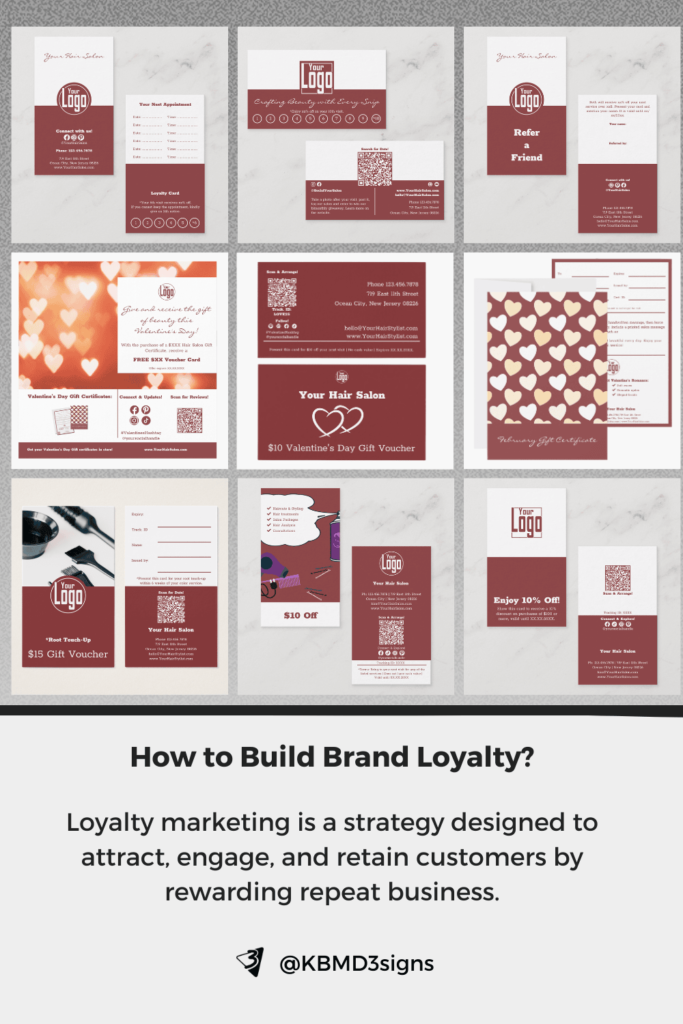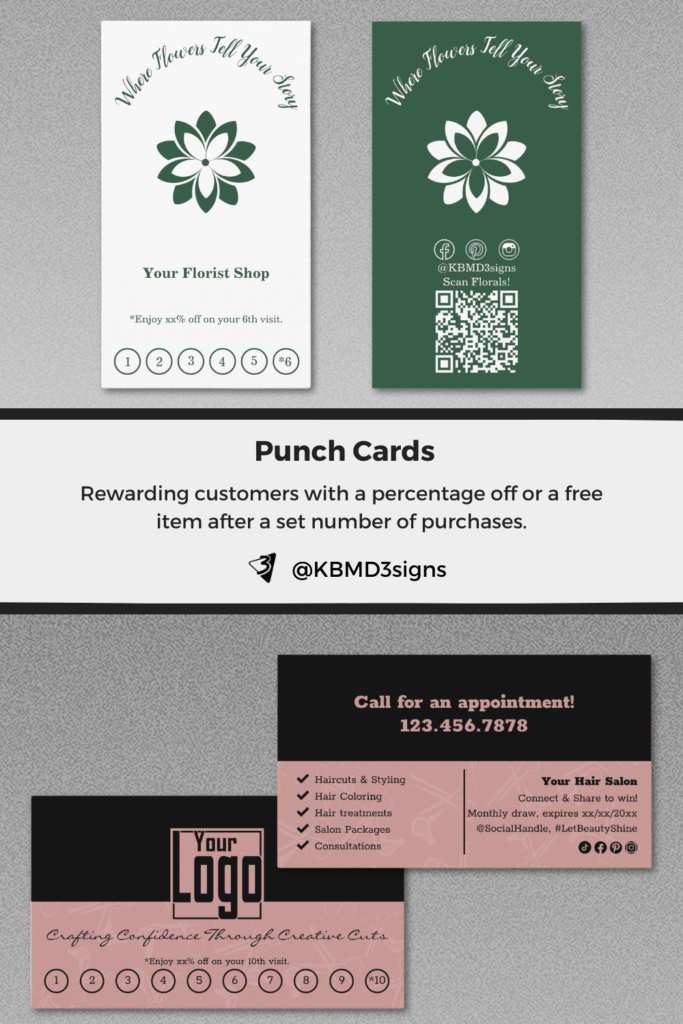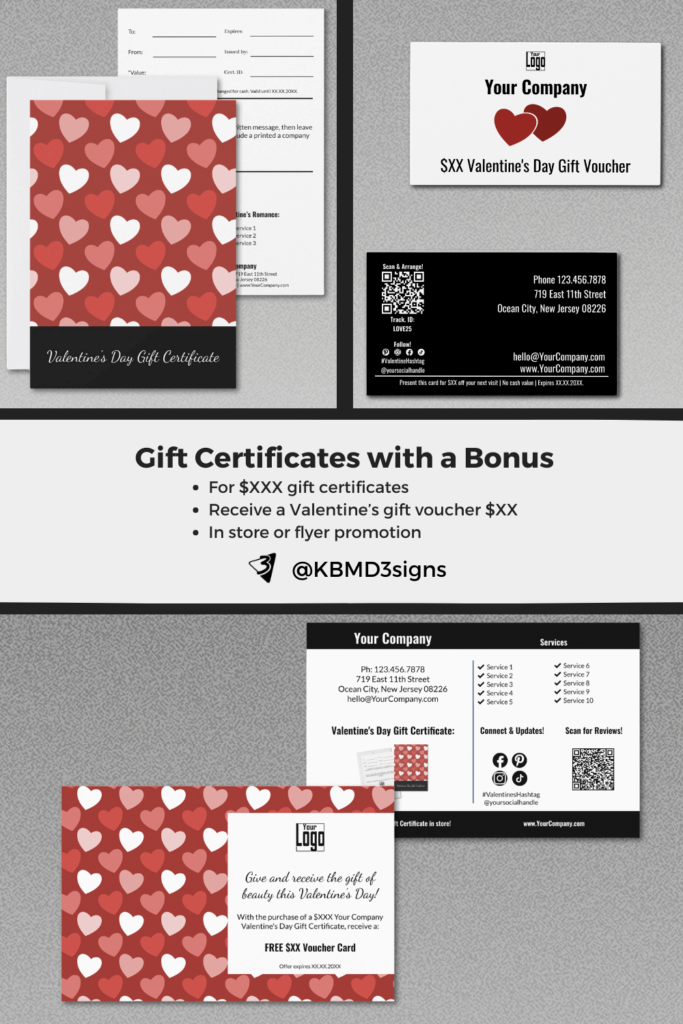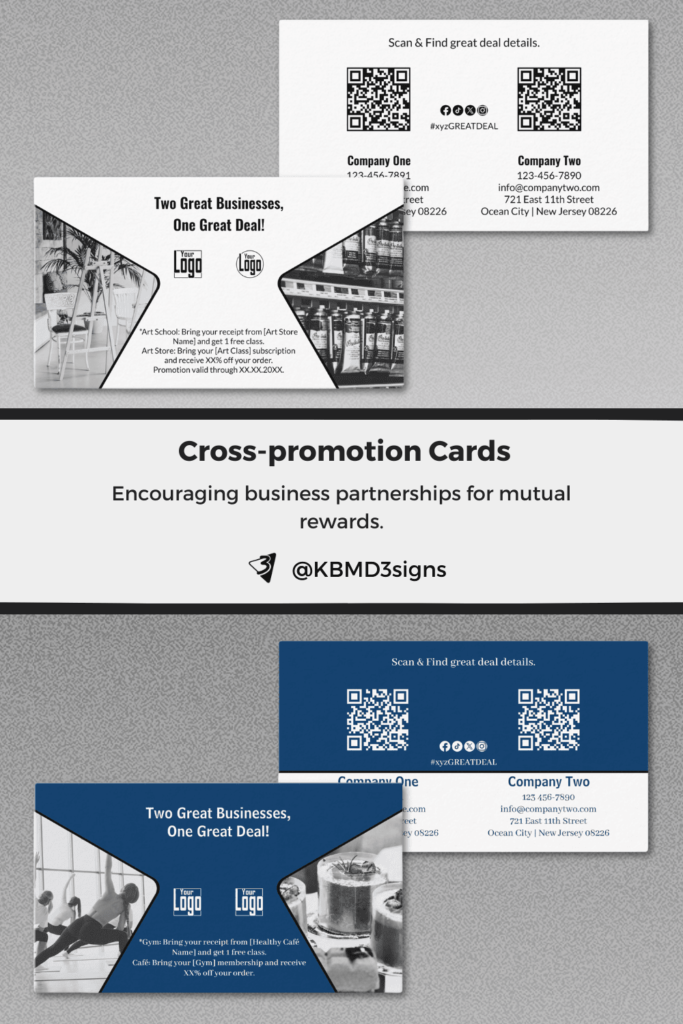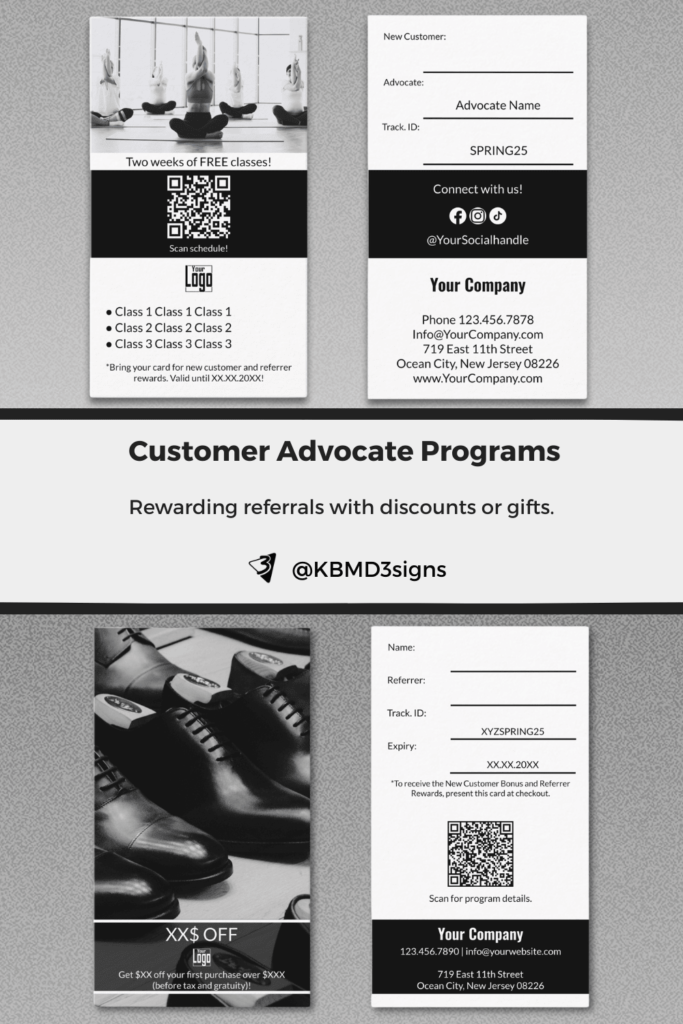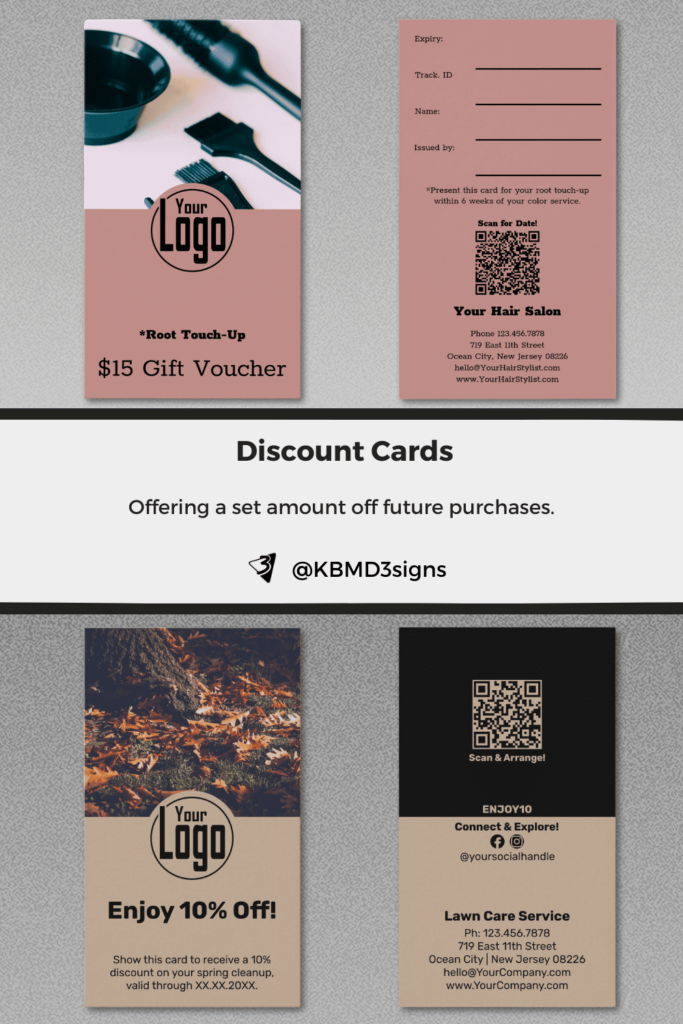How to Build Brand Loyalty Using Offline Tools, today’s competitive market requires small local businesses to focus on retaining customers and building a loyal community around their brand. Brand loyalty not only ensures repeat business, but also turns happy customers into enthusiastic advocates. This guide explores brand loyalty, loyalty marketing, and loyalty programs while offering insights into which types of programs best suit different small businesses.
Article Content:
- Understanding Customer Loyalty vs. Brand Loyalty
- Steps to Build Brand Loyalty
- What is Loyalty Marketing?
- What is a Loyalty Program?
- What Types of Loyalty Programs Are There?
- What Type of Small Business Profits from What Type of Loyalty Program?
- The Correlation Between Loyalty Programs and Referral Programs
- Loyalty Card Designs by KBM D3signs
- Tracking Loyalty Program Success
- Frequently Asked Questions (FAQs)
1. Understanding Customer Loyalty vs. Brand Loyalty
Customer loyalty and brand loyalty are often used interchangeably, but they have distinct differences:
- Customer Loyalty is driven by factors such as pricing, convenience, and promotions. A customer may repeatedly buy from a business due to affordability or location but is open to switching if a better deal arises.
- Brand Loyalty is based on an emotional connection. A loyal customer continues to support a brand because they identify with its values, mission, and quality, regardless of competitive pricing or convenience.
For small businesses, building brand loyalty is key to long-term success as it fosters a committed customer base that supports and promotes the business.
2. Steps to Build Brand Loyalty
- Deliver Exceptional Customer Service – Train employees to provide friendly, personalized service that makes customers feel valued.
- Engage with the Community – Sponsor local events, participate in charity drives, and connect with customers in meaningful ways.
- Offer Exclusive Perks – Provide VIP discounts, early access to new products, or special deals to repeat customers.
- Create a Unique Brand Identity – Develop a recognizable logo, consistent messaging, and a strong mission that resonates with customers.
- Encourage Word-of-Mouth Marketing – Reward customers for referrals and positive reviews to expand brand reach.
3. What is Loyalty Marketing?
Loyalty marketing is a strategy designed to attract, engage, and retain customers by rewarding repeat business. It strengthens the emotional bond between the brand and customers, encouraging continued engagement. This can be done through personalized rewards, exceptional service, and unique value propositions that keep customers returning.
4. What is a Loyalty Program?
A loyalty program is a structured initiative designed to encourage repeat business by offering rewards, discounts, or exclusive benefits. These programs motivate customers to continue shopping or using services by providing incentives based on their purchase history and interactions.
5. What Types of Loyalty Programs Are There?
There are several types of loyalty programs that small businesses can implement:
Punch Cards
Customers receive a stamp or punch for each purchase, and after a set number, they receive a discount or free branded product/service.
Example: A coffee shop offers a free coffee after 10 purchases.
Gift Card Bonus Programs
Customers who buy a gift card receive an additional voucher or bonus credit.
Example: A salon offers a $10 bonus voucher when purchasing a $50 gift card.
Referral Programs
Customers earn rewards by referring new customers.
Example: A fitness center offers a free personal training session after three successful referrals.
Cross-Promotion Loyalty Cards
Two businesses collaborate to offer rewards, increasing exposure for both.
Example: A local bakery and coffee shop offer a combined loyalty card where purchases at either contribute to rewards.
Discount Cards
Customers receive a set discount or a percentage off future purchases.
Example: A boutique offers a 10% discount card valid for six months after a major purchase.
6. What Type of Small Business Profits from What Type of Loyalty Program?
Different loyalty programs work better for different businesses:
- Retail stores and cafés: Punch cards and discount cards encourage repeat purchases.
- Service-based businesses: Referral programs help expand customer reach.
- Salons and spas: Gift card bonuses and discount cards build long-term customer relationships.
- Gyms and fitness centers: Referral and advocate programs increase membership sign-ups.
- Restaurants: Cross-promotions with local businesses help drive foot traffic.
7. The Correlation Between Loyalty Programs and Referral Programs
Loyalty programs and referral programs go hand in hand. While loyalty programs focus on retaining customers, referral programs help businesses attract new ones through word-of-mouth marketing. A well-designed strategy should integrate both to maximize customer retention and acquisition.
8. Loyalty Card Designs by KBM D3signs
Punch cards – Rewarding customers with a percentage off or a free item after a set number of purchases.
Gift card bonus – Offering an additional voucher with gift card purchases.
Cross-promotion cards – Encouraging business partnerships for mutual rewards.
Customer advocate programs – Rewarding referrals with discounts or gifts.
Discount cards – Offering a set amount off future purchases.
Discover the Uniqueness of Loyalty Card Designs by KBM D3signs
Our commitment to our mission is reflected in the exceptional loyalty cards designed by KBM D3signs. We strive to simplify the customization process by offering easily customizable templates within our marketing packages. Our belief is rooted in the idea that everyone should have the freedom to choose their preferred colors for a selected design, ensuring that it perfectly matches your vision and needs.
Shop at Zazzle Store
Cocoon It! – Shop to Build Brand Loyalty
At the Cocoon It! Store by KBM D3signs on Zazzle puts all the branding elements and color schemes in your hands. Whether you’re choosing products with a QR code – where the second color is limited to black or white for optimal contrast – or exploring the vast array of customizable elements through the “Edit further” link, your brand’s unique identity is yours to define.
We use color tools to help you choose the perfect hues, and for additional inspiration, explore our curated collection of color palette ideas. Our commitment to customization goes beyond placeholders-almost all elements can be customized to match your chosen brand colors.
If you need additional assistance customizing or transferring designs to different products, or if you have a unique vision that requires a custom design, we are just a message away. At Designs by KBM D3signs, we go beyond providing marketing materials; we empower you to shape and showcase your brand with creativity and personalization.
Show off your personal style or post a review!
9. Tracking Loyalty Program Success
To ensure that a loyalty program is truly effective, small businesses must track and analyze key performance indicators (KPIs). Understanding the impact of a loyalty initiative helps determine whether adjustments are needed to maximize customer retention and business growth.
Measuring the Impact: Hypothetical Scenarios
While every business will experience different results, tracking actual data will help validate success. Here are some hypothetical examples illustrating how loyalty programs can influence customer retention:
Punch Card Impact on a Local Café
By implementing a punch card system, a small café noticed a significant increase in customer retention, with approximately 30% of their customers returning more frequently. Tracking redemption rates helped them fine-tune their reward structure for better engagement.
Referral Program Growth in a Salon
A salon offering free services after three successful referrals saw rapid word-of-mouth growth, doubling its client base within a year. Measuring referral rates helped them determine which services were most appealing for promotions.
Discount Card Strategy for a Boutique
A boutique offering a long-term discount card retained approximately 75% of customers for repeat purchases. By tracking usage patterns, they were able to tweak the program to offer exclusive seasonal discounts that further increased engagement.
Why Tracking Matters
Tracking loyalty programs allows businesses to:
- Identify high-performing strategies and eliminate ineffective ones.
- Adjust reward structures to maximize customer engagement.
- Measure customer retention rates and program participation.
- Understand customer buying behavior to refine marketing efforts.
By monitoring redemption rates, customer return frequency, and referral success, businesses can make data-driven decisions to continuously improve their loyalty programs.
-

6 Winter Marketing Ideas for Small Businesses
Read the post …: 6 Winter Marketing Ideas for Small Businesses -

6 Offline Summer Marketing Ideas for Small Businesses
Read the post …: 6 Offline Summer Marketing Ideas for Small Businesses -

What is Seasonal Marketing? A Guide for Small Business Offline Success
Read the post …: What is Seasonal Marketing? A Guide for Small Business Offline Success
10. Frequently Asked Questions (FAQs)
Building brand loyalty offline involves providing exceptional customer service, offering personalized experiences, and implementing loyalty programs that reward repeat customers.
Yes, loyalty programs encourage repeat business, increase customer retention, and enhance word-of-mouth marketing, ultimately leading to higher revenue.
Referral programs attract new customers while loyalty programs retain them. Integrating both maximizes customer lifetime value.
A referral program or a discount card works best for service-based businesses like salons, fitness centers, and spas.
Yes, personalized and community-driven loyalty programs give small businesses a competitive edge by fostering strong customer relationships.
By leveraging offline loyalty tools and strategies, small businesses can cultivate brand loyalty, ensuring long-term success and customer satisfaction.
-

What Is A Brand Partnership? – A Small Business Perspective
Read the post …: What Is A Brand Partnership? – A Small Business Perspective -
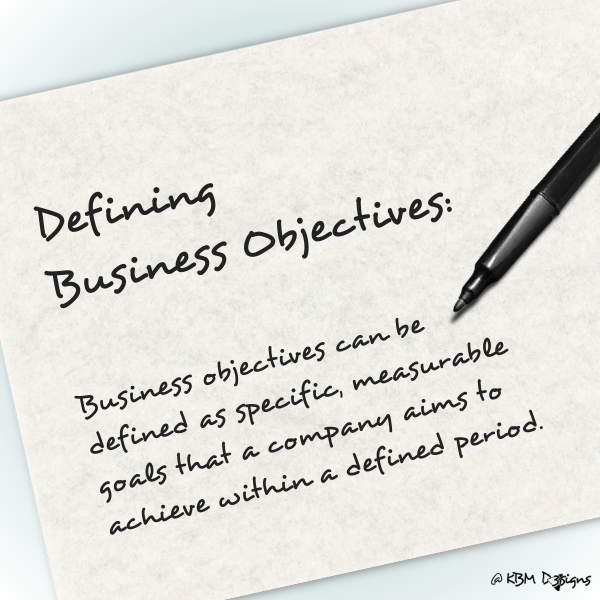
What Are Business Objectives?” Perspective Of A Small Business
Read the post …: What Are Business Objectives?” Perspective Of A Small Business -

What Is A Focus Group Market Research? – SMB Perspective
Read the post …: What Is A Focus Group Market Research? – SMB Perspective


